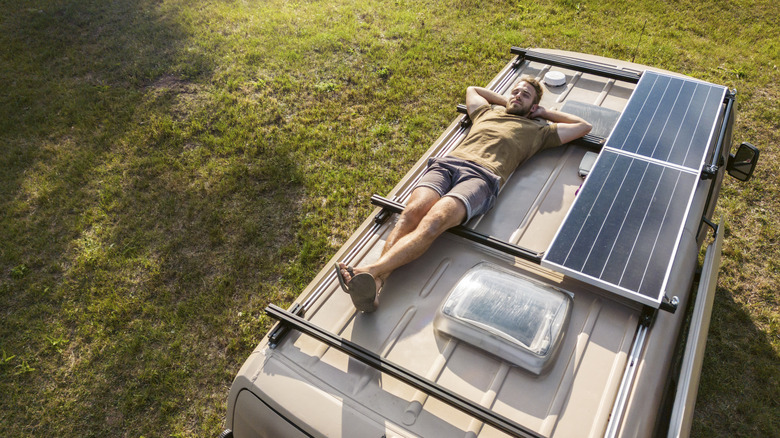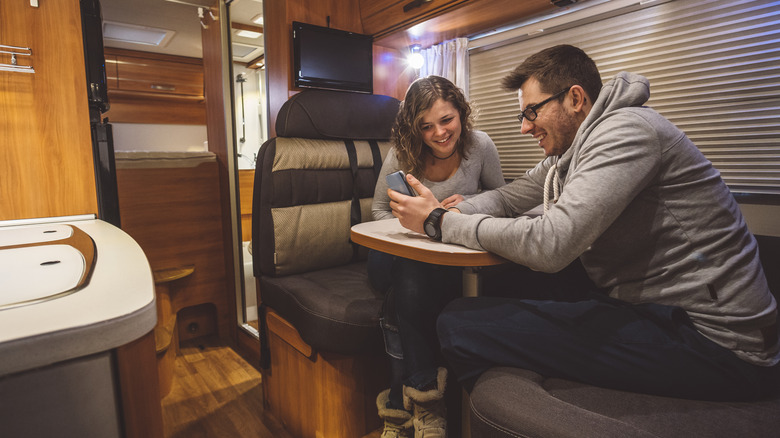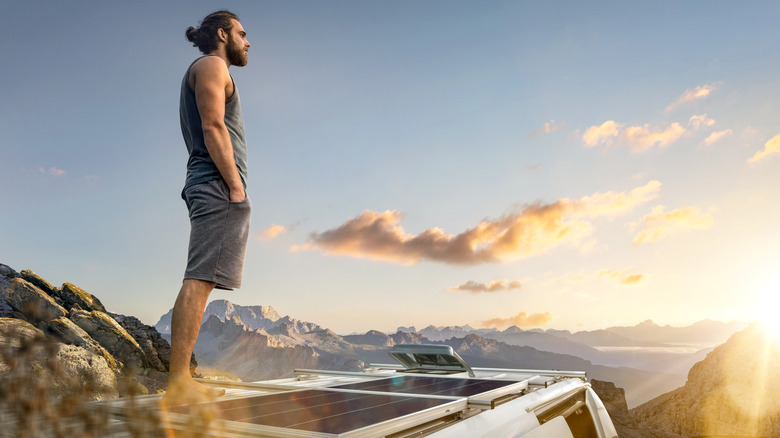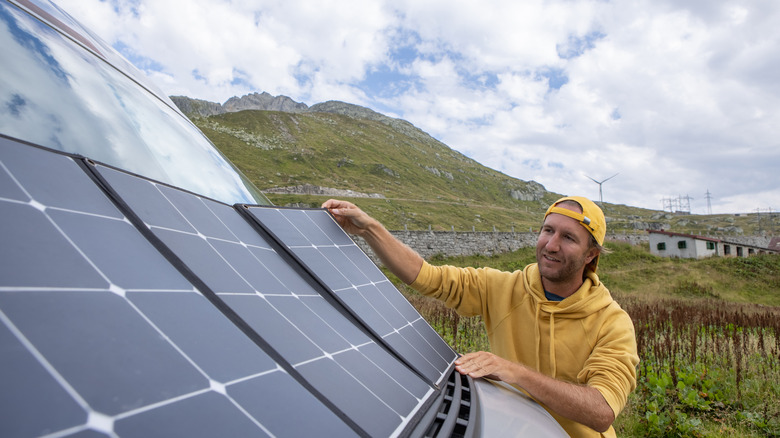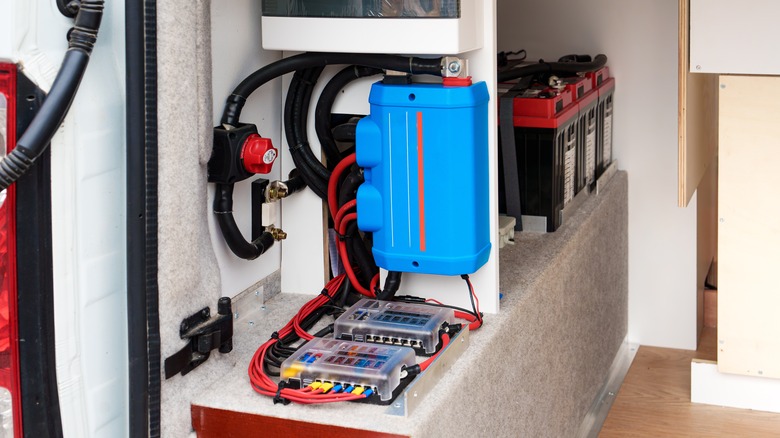How Many Solar Panels Does It Take To Power An RV/Motorhome?
RVs and motorhomes are the perfect candidates for solar electricity. Not only is solar more eco-friendly and less polluting than gas generators, but it's much quieter. Anyone who's ever hunkered down in an RV campground only to be kept awake by the droning rumble of their neighbors' gas generators knows this for fact.
Thus, installing solar panels on your RV is a fantastic idea. Of course, it can be a somewhat pricey initial investment, even with the recent decline in costs of solar power. Our article on what to know before installing solar panels on your RV explains how it's an affordable endeavor, but not a cheap one. There are also expenses like hardware, installation costs, and even possible retrofitting of your RV to accommodate the new hookup. The first question, however, is how many solar panels you'll actually need.
The question is simple, while the answer is a bit complicated. As you might expect, not every RVer requires the same amount. Factors like sun exposure, personal energy consumption, solar panel model size and capacity, energy storage options, and mounting hardware will determine the number of panels you'll need.
But coming up with an estimate doesn't have to be overwhelming. Here, we've broken down the steps into a straightforward guide to help you get an idea of how many solar panels you'll need to power your RV. This uses many of the same principles as our guide on calculating how many solar panels are needed to power a tiny home, though there are some key differences that we'll go over.
Step 1: Estimate how much solar energy you need per day
Before determining how many solar panels you need, you'll first have to estimate how much daily energy you typically use.
To get an estimate, you can add up the daily power consumption of your RV's major appliances. Make a list of all the electronics in your RV. Then, label each with their indicated wattage. Many common appliances, like refrigerators and televisions, are stamped with their wattage on their back panels.
If a device isn't labeled, you can search its model online to find it. You can also search the web for a common wattage of that particular appliance, or refer to the common wattages list provided by EcoFlow. Some devices indicate their voltage and amperage instead, but you can simply multiply the two to get the wattage.
Once you have a list of your appliances and their wattages, estimate how many hours per day you use each. Then, multiply each appliance's wattage by the hours per day you use it, and add everything up. This will provide your total Watt-hours per day you need.
For example, let's say you have a 100W television running 2 hours per day, a 60W refrigerator running 24 hours per day, and a 400W space heater running for 1 hour per day. To find the total, multiply each device's wattage by its daily usage and add everything up.
- (100W television) x (2hr/day) = 200Wh/day
- (60W refrigerator) x (24hr/day) = 1,440Wh/day
- (400W space heater) x (1hr/day) = 800Wh/day
- Total Wh/day = (200Wh/day) + (1,040Wh/day) + (800Wh/day) = 2,040Wh/day
This is an example, so you'll likely have more appliances to include. Whatever number you come up with, write it down to keep it on hand for the next steps.
Step 2: Decide what kind of solar panels you'll use
Solar panels have different output ratings, depending on the model. Some are smaller and more efficient, like monocrystalline panels, but they typically cost more. Cheaper options, like polycrystalline panels, are usually less energy- and space-efficient. The third type, thin-film flexible panels, offers easy installation, though they don't last very long –- they're also the least efficient.
Thus, if the available roof space on your RV is limited, you may have to go with monocrystalline panels to make the most of their space-efficiency. You can compare the different model sizes prices, and output ratings on merchants' websites. You can also check out the 5 best solar panels for RVs to see which one works for you. If you can't decide just yet, consider applying the following calculation to each type to see what the final price and space occupancy comes to.
For our calculation, you'll need to find the power output rating of your panel-of-choice. Typically, these range between 100W and 400W. This number indicates the watts the panel can generate in an hour during peak sunlight exposure. When you have a solar panel in mind, write down its power output rating.
Step 3: Estimate the daily solar potential of your area
Now that you have the output rating of your solar panel, you'll have to estimate how many hours of sunlight it will receive per day. To get this number, we recommend looking up your area's solar exposure using either Unbound Solar or Google Project Sunroof.
Of course, in an RV, you'll be moving around, so the daily sunlight will vary depending on your location. To counter this variability, you can map out your travel plans and look up the daily solar exposure of each location. Then, use the daily sunlight exposure of whichever area has the least amount of exposure. That way, you'll have enough solar power in every scenario.
For example, let's say you're traveling from Atlanta, Georgia to Acadia National Park in Maine. Along the way, you intend to stop in Charlotte, Harrisburg, and Hartford. Looking these cities up on Google Project Sunroof, we get the following daily average sunlight exposure:
- Atlanta, GA: 4.3hr
- Charlotte, NC: 4.1hr
- Harrisburg, PA: 3.9hr
- Hartford, CT: 4.0hr
- Acadia National Park, ME: 3.7hr
Thus, you should use Acadia National Park's daily sunlight exposure for the calculation, since it's the least amount. Keep in mind, however, that this value is for your estimate. The idea that solar panels can't generate energy when it's cloudy is one of the common myths about solar panels.
Note: Google Project Sunroof provides the annual hours of sun exposure, so we divided each location's annual sun exposure by 365 to get a daily average.
Step 4: Calculate how many solar panels you'll need
At this point, you should have an estimate of your daily power consumption, your solar panel's energy output rating, and the average hours of daily sun exposure you'll receive. Now, calculating how many solar panels it will take to power your RV is as simple as plugging in the numbers.
- (Solar panel energy output rating) x (Daily solar potential in hours) = Daily power generation of one panel
- (Daily power consumption) / (Daily power generation of one panel) = Number of solar panels you'll need
Here's an example. Let's say your solar-panel-of-choice's output rating is 300W. Your destination, Acadia National Park, receives an average of 3.7 hours of peak sunlight a day. Your daily power consumption in your RV is about 4,000W. Plugging in the numbers to the above formula, we get the following:
- (300W) x (3.7h) = 1,110Wh
- (4,000W) / (1,110Wh) = 3.6 ≈ 4
Thus, you would need four 300W solar panels to power your RV.
The final consideration: Battery storage
Without batteries to store the electricity your solar panels generate, you'll only have power while the sun is shining. Furthermore, batteries for solar energy storage are often part of larger battery "bank" systems, which regulate the flow of electricity to avoid frying your electronics. (They're sometimes called "Battery Management Systems" and "charge controllers.") Thus, these systems not only provide energy storage, but they also add greater control and security to your setup.
Fortunately, battery technology is rapidly improving these days, and prices are dropping as a result. The five top brands for deep cycle RV batteries often offer complete solar kits with batteries and charge controllers included. Better yet, most solar power batteries list their storage capacity in watts, making your daily power consumption value calculated in Step 1 useful yet again. For example, you can compare the different AM Solar models and their various capacities to get an idea of how many batteries you'll need to meet your daily power consumption needs.
